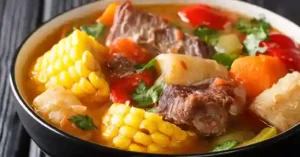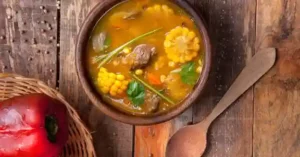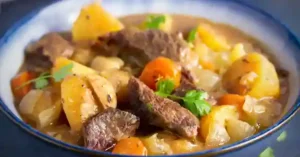This chicken potato soup is hearty, comforting, and easy to make. It’s packed with tender chicken, soft potatoes, and rich flavor in every bite. Whether you love creamy soups or brothy bowls, this recipe can do both. Perfect for busy weeknights or cozy weekends. Keep reading to learn the best ingredients, tips, and step-by-step instructions to make it just right.

Introduction: Why You’ll Love This Chicken Potato Soup Recipe
Chicken potato soup is the kind of meal that brings comfort in every spoonful. It’s warm, filling, and full of wholesome ingredients—perfect for chilly nights, sick days, or when you just need something satisfying and simple.
Here’s why this soup deserves a spot in your regular recipe rotation:
- One-pot simplicity: Minimal cleanup, maximum flavor.
- Customizable: Make it creamy, brothy, spicy, or mild—your call.
- Hearty and nutritious: Loaded with protein, fiber, and essential nutrients.
- Great for leftovers: Tastes even better the next day.
- Family-friendly: Loved by kids and adults alike.
Whether you’re craving a comforting classic or looking for a new go-to weeknight meal, this chicken potato soup delivers. Keep reading to learn everything you need to make the perfect bowl—from ingredients to storage tips.

Ingredients Overview
To make the best chicken potato soup, you’ll need a handful of simple, wholesome ingredients. Each one adds flavor, texture, or body to the soup. Here’s what goes into a classic version, plus ideas for substitutions and add-ins.
Main Ingredients:
- Chicken: Boneless, skinless chicken breasts or thighs work well. Thighs offer richer flavor; breasts are leaner.
- Potatoes: Yukon Gold or Russet potatoes are ideal. They soften nicely and add a creamy texture.
- Carrots: Adds natural sweetness and color.
- Celery: Brings classic soup flavor and crunch.
- Onion: Yellow or white onion, diced finely, forms the aromatic base.
- Garlic: Fresh minced garlic deepens the flavor.
- Chicken broth: Use low-sodium store-bought or homemade broth for full-bodied taste.
Optional Ingredients & Variations:
- Cream or milk: For a creamy version, add heavy cream, half-and-half, or whole milk near the end of cooking.
- Butter or olive oil: To sauté vegetables or enrich the soup.
- Herbs: Fresh thyme, rosemary, parsley, or bay leaf add earthiness and depth.
- Corn, peas, or spinach: Stir in toward the end for extra nutrients and color.
- Cheese: A handful of shredded cheddar or parmesan can add richness.
Seasonings:
- Salt and pepper: Always to taste.
- Dried herbs: Like thyme, oregano, or basil.
- Paprika or cayenne: Optional, for a mild kick.
- Lemon juice: A splash at the end brightens the whole dish.
Ingredient Substitutions:
- Dairy-free? Use coconut milk or almond milk instead of cream.
- Low-carb? Swap potatoes for cauliflower florets.
- No fresh garlic? Use ½ teaspoon of garlic powder.
- Vegetarian? Replace chicken with chickpeas and use vegetable broth.

Tools You’ll Need
Making chicken potato soup doesn’t require fancy equipment—just a few basic kitchen tools to get the job done smoothly. Whether you’re cooking on the stovetop, in a Crock-Pot, or with an Instant Pot, here’s what you’ll need:
Essential Tools:
Large Soup Pot or Dutch Oven
A heavy-bottomed pot holds all the ingredients and helps distribute heat evenly. A 5–6 quart size works well.
Cutting Board & Sharp Knife
For chopping potatoes, carrots, celery, onion, and chicken.
Wooden Spoon or Ladle
Useful for stirring the soup while it simmers and for serving.
Measuring Cups & Spoons
To get the right balance of broth, cream, and seasonings.
Optional Tools (for Alternate Cooking Methods):
Instant Pot
Cuts down cooking time. Great if you’re in a hurry but want deep flavor fast.
Crock-Pot (Slow Cooker)
Perfect for hands-off cooking. Set it and forget it.
Immersion Blender (for creamy versions)
Blend part of the soup directly in the pot to thicken without cream or flour.
Nice-to-Have Extras:
Soup Bowls & Storage Containers
For serving and storing leftovers easily.
Grater or Zester
Handy if you’re adding cheese or fresh lemon zest for extra flavor.

Step-by-Step Instructions
This chicken potato soup comes together in one pot with simple steps. Below are instructions for the stovetop method, along with Instant Pot and Crock-Pot variations for added convenience.
Stovetop Method (Default Recipe)
Sauté Aromatics:
In a large soup pot or Dutch oven, heat 1–2 tablespoons of olive oil or butter over medium heat. Add chopped onions, carrots, and celery. Cook for 4–5 minutes until softened. Stir in minced garlic and cook for another 30 seconds.
Add Chicken and Seasonings:
Place diced chicken into the pot. Season with salt, pepper, dried herbs (like thyme or oregano), and optional paprika. Cook for 3–4 minutes until lightly browned (it doesn’t need to be fully cooked through).
Add Potatoes and Broth:
Add chopped potatoes and pour in the chicken broth. Bring to a boil, then reduce heat to a simmer. Cover and cook for 20–25 minutes, or until the potatoes are fork-tender and chicken is fully cooked.
(Optional) Make It Creamy:
For a creamy version, stir in ½ to 1 cup of heavy cream, half-and-half, or milk. Simmer for another 5 minutes. You can also blend 1–2 cups of the soup with an immersion blender and stir it back in for a thicker texture.
Taste and Adjust:
Taste the soup and adjust seasonings as needed. Add a splash of lemon juice or a sprinkle of fresh herbs if desired.
Serve:
Ladle into bowls and serve hot with bread, crackers, or a fresh salad.
Instant Pot Method
Use the sauté function to cook aromatics and chicken as described above. Add potatoes, broth, and seasonings. Seal the lid, set to Pressure Cook on High for 10 minutes. Allow a natural pressure release for 5 minutes, then quick release the rest. Stir in cream (if using), adjust seasoning, and serve.
Crock-Pot (Slow Cooker) Method
Add all ingredients—except dairy—to the slow cooker. Cook on Low for 6–7 hours or High for 3–4 hours. Add cream during the last 15–20 minutes if using. Stir, season to taste, and serve warm.

Pro Tips for the Best Flavor
Want to take your chicken potato soup from good to unforgettable? These expert tips will help you build deeper flavor, improve texture, and make the soup even more satisfying every time.
Sear the Chicken First
Even though the chicken will simmer in broth, browning it briefly before boiling adds a rich, savory depth. If you’re using raw chicken, don’t skip this step.
Use Chicken Thighs for More Flavor
Boneless, skinless thighs are juicier and more flavorful than breasts. They also stay tender during long cooking.
Don’t Overcook the Potatoes
Simmer potatoes just until fork-tender. Overcooked potatoes can fall apart and make the soup grainy or mushy.
Add Acid at the End
A splash of lemon juice or vinegar right before serving brightens the entire soup and balances out the richness.
Blend a Portion for Creaminess (No Cream Needed)
For a naturally creamy soup without dairy, blend 1–2 cups of the finished soup with an immersion blender and stir it back in. It thickens the broth while keeping the chunky texture.
Let It Rest Before Serving
Once cooked, let the soup sit covered for 10 minutes off heat. This helps flavors meld and makes the soup taste even better.
Taste As You Go
Don’t just season at the end. Taste and adjust salt, pepper, and herbs throughout the cooking process for balanced flavor.
Use Homemade or High-Quality Broth
The broth forms the base of the soup—using a rich, flavorful broth (store-bought or homemade) makes all the difference.

Serving Suggestions
Chicken potato soup is delicious on its own—but the right pairings and garnishes can elevate it into a satisfying, well-rounded meal. Whether you’re serving a casual family dinner or comforting someone on a cold day, here are some great ways to enjoy it.
Bread on the Side
- Crusty Artisan Bread: Perfect for dipping and soaking up the broth.
- Garlic Bread or Toast: Adds a flavorful crunch.
- Buttery Biscuits or Dinner Rolls: Soft, comforting, and ideal with creamy versions.
Toppings & Garnishes
- Fresh Herbs: Sprinkle chopped parsley, thyme, or chives for color and freshness.
- Cracked Black Pepper: Enhances flavor just before serving.
- Grated Cheese: Try sharp cheddar, parmesan, or gouda for a rich, melty finish.
- Bacon Bits or Crispy Onions: Adds crunch and a smoky kick.
- A Dollop of Sour Cream or Greek Yogurt: Balances heat and adds creaminess.
Light Side Dishes
- Simple Green Salad: With vinaigrette or lemon dressing to brighten the meal.
- Roasted Vegetables: Like Brussels sprouts, asparagus, or carrots.
- Grilled Cheese Sandwich: For a cozy, indulgent lunch or dinner pairing.
Meal Prep Ideas
- Serve in Bread Bowls: For a fun and filling presentation.
- Soup & Sandwich Combo: Pair with turkey, ham, or veggie paninis.
Serving for Guests or Meal Trains?
Package with toppings on the side and reheating instructions. Add a small dessert like cookies or fruit for a complete comforting meal.

Substitutions and Variations
Chicken potato soup is a flexible recipe that can be easily adapted to fit different tastes, dietary needs, and ingredient availability. Whether you’re making it lighter, dairy-free, or just want to change up the flavor, here are the best ways to customize your soup.
Protein Substitutes
- Rotisserie Chicken: A great time-saver. Shred and add it in the last 10 minutes of cooking.
- Turkey: A flavorful alternative, especially for post-holiday leftovers.
- Chickpeas or White Beans: For a vegetarian version that still has protein and heartiness.
- Tofu: Use firm tofu cubes for a plant-based option.
Potato Options
- Yukon Gold: Creamy and hold their shape well.
- Russet: Break down more and help naturally thicken the soup.
- Red Potatoes: Waxy, hold their texture nicely.
- Sweet Potatoes: For a slightly sweet, nutrient-packed twist.
Dairy-Free or Cream-Free Variations
- Coconut Milk: Adds creaminess and a hint of sweetness (great with curry-style versions).
- Almond or Oat Milk: Mild, plant-based options for a lighter texture.
- Blend Some Potatoes: As a natural thickener without dairy.
Add-in Ideas for More Flavor or Nutrition
- Leafy Greens: Stir in spinach, kale, or Swiss chard during the last 5 minutes.
- Corn or Peas: Adds color, sweetness, and texture.
- Mushrooms: For an earthy flavor boost.
- Chili Flakes or Cayenne: To bring gentle heat.
Herb & Seasoning Variations
- Italian Twist: Add basil, oregano, and finish with parmesan.
- Lemony Greek Style: Use lemon juice, dill, and a touch of olive oil.
- Southwest Flavor: Add cumin, smoked paprika, corn, and top with avocado.
Low-Carb or Keto Version
- Swap Potatoes with Cauliflower: Similar texture with fewer carbs.
- Use Heavy Cream or Cheese: To boost fat content for keto diets.
- Skip Starchy Vegetables: Leave out carrots and peas if needed.

Storage and Leftovers
Chicken potato soup stores well and can taste even better the next day as the flavors continue to develop. Whether you’re meal prepping or saving extra portions, here’s how to store, freeze, and reheat your soup to keep it tasting fresh.
Storing in the Refrigerator
Cool First:
Let the soup cool to room temperature before storing. This helps prevent condensation and preserves texture.
Use Airtight Containers:
Store in glass or plastic containers with tight-fitting lids. Mason jars also work well for single portions.
Refrigeration Time:
The soup will stay fresh in the fridge for up to 4 days.
Freezing Instructions
Freeze Without Cream (If Possible):
Dairy can sometimes separate when frozen and reheated. If you’re planning to freeze, consider freezing it before adding cream, and stir it in fresh when reheating.
Portion First:
Freeze in individual servings using freezer-safe containers or silicone soup cubes. This makes it easy to thaw just what you need.
Label and Date:
Clearly label with the date to keep track. For best quality, use within 2 to 3 months.
Reheating Tips
Stovetop:
Reheat over medium heat, stirring occasionally. Add a splash of broth or water if the soup is too thick.
Microwave:
Heat in a microwave-safe bowl in 1-minute intervals, stirring in between. Cover loosely to prevent splatters.
From Frozen:
Thaw overnight in the fridge before reheating, or reheat directly from frozen on the stove over low heat.
Texture Tips After Storage
If It’s Too Thick:
Stir in a bit of chicken broth, milk, or water to loosen it up.
If Potatoes Get Mushy:
Gently mash them into the soup for a thicker consistency or blend a portion for a creamy texture.

Nutrition Information
Chicken potato soup is not only cozy and filling—it’s also a wholesome meal packed with protein, fiber, and essential nutrients. Here’s a general nutrition breakdown per serving, based on a classic, creamy version made with chicken breast, potatoes, carrots, and a splash of cream.
Estimated Nutrition Per Serving
(Based on a 1.5-cup serving; yields approx. 6 servings)
- Calories: ~310
- Protein: 24g
- Carbohydrates: 26g
- Fat: 13g
- Saturated Fat: 5g
- Fiber: 3g
- Sugars: 4g
- Cholesterol: 70mg
- Sodium: ~600mg (varies with broth used)
Key Nutritional Highlights
- High in Protein: Lean chicken provides muscle-building protein.
- Rich in Vitamins: Carrots and potatoes add Vitamin A, Vitamin C, and potassium.
- Gluten-Free Friendly: Naturally gluten-free if no flour or thickening agents are added.
- Customizable for Lower Fat or Dairy-Free Diets: Easily adjust cream and oil usage.
How to Make It Healthier
- Reduce Sodium: Use low-sodium chicken broth and season to taste.
- Skip the Cream: Omit or replace with unsweetened plant-based milk or blended potatoes.
- Add More Veggies: Mix in spinach, peas, or cauliflower for added fiber and nutrients.
- Use Chicken Thighs for Healthy Fats: Though slightly higher in fat, thighs add heart-healthy unsaturated fats.
Conclusion
Chicken potato soup is the perfect blend of comfort, nutrition, and ease. With simple ingredients, flexible methods, and endless variations, it’s a recipe you can turn to all year round. Whether you like it creamy or brothy, classic or loaded with extras, this soup delivers warmth and flavor in every bowl. Try it once, and it might just become a new family favorite.
FAQS

Chicken Potato Soup Recipe
Ingredients
Method
- In a large pot, melt the butter with the olive oil over medium heat. Add the diced onions, carrots and celery, and sauté for 7-8 minutes.
- Stir in the garlic, rosemary, and thyme, and cook for another 1-2 minutes,
- Add the chicken breast pieces to the pot and cook until the chicken is browned on all sides.
- Sprinkle the plain flour over the chicken and vegetables, stirring well to coat.
- Slowly pour in the milk, a little at a time, stirring constantly to ensure a smooth mixture and prevent lumps.
- Add the diced potatoes, then pour in the chicken stock, stirring to lift any bits stuck to the bottom of the pot.
- Bring the mixture to a boil, then reduce the heat to low. Allow the soup to simmer for about 20-25 minutes or until the potatoes are tender.
- Add the low-fat cheddar cheese to the pot, stirring until it's fully melted into the soup.
- Stir in the fresh parsley, then season with salt and freshly ground black pepper to taste.
